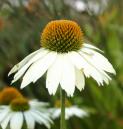Agaric.*
*The following is taken from the new edition of King's American Dispensatory.
History.—This is obtained from various fungus plants of the mushroom tribe. These plants afford a great diversity of form and structure, being in their simplest character little articulated filaments, composed of chains or cellules, as in the mildew of the rosebush, and in moldiness, mucor; again, they may present an even and imperforate surface, and another separated into plates or cells, in which the sporules are deposited. They absorb a great amount of oxygen with evolution of hydrogen and carbonic acid gas, and contain considerable proportions of nitrogen. They are destructive to nearly all organic matter upon which they grow. According to Dr. M. A Curtis, of N. C., the genus boletus, as now constituted, includes only fleshy species, with a hymenium composed of sporable tubes. Those species formerly included in Boletus, and whose hymenium is composed of pores, now form the genus Polyporus."
The Polyporus Officinalis (Boletus Laricis), known by the name of White Agaric, Purging Agaric, etc., is procured from Asia, Corinthia, Russia, Central America, and the Rocky Mountains, where it is found growing upon the Larch. It is in masses, varying from the size of an ordinary apple to that of a large nutmeg-melon; its shape somewhat resembles a horse's hoof; it is reddish-gray or yellow externally, whitish internally, and of a spongy, friable consistence; hymenium concrete; substance of the pileus consisting of subrotund pores, with their simple dissepiments; pileus corky-fleshy, ungulate, zoned, smooth; pores yellowish; it has a feeble odor, and a bitter, acid, somewhat sweetish taste. Braconnot found in it 72 parts resinous matter, 2 bitter extractive, 26 of a nutritious animalized principle, which he termed fungin. Benzoic acid and several salts have likewise been found in it. It is collected in August and September, deprived of its outer covering, and then dried and placed in the sun.
The Polyporus (Boletus) Ignarius, Agaric of the Oak, is a fungus found on the oak, cherry, willow, plum, and other trees; when young it is soft, but gradually becomes hard and woody. In shape it somewhat resembles the preceding; its upper smooth surface is marked with dark circular ridges, and its under is very porous, and of a yellowish-white color. It is tasteless and inodorous. The Polyporus (Boletus) Fomentarius, growing on similar trees with the P. Ignarius, when cut in slices, beaten, soaked in a solution of nitre, and dried, forms, an inflammable substance, known as Spunk, Amadou, or German Tinder. The Polyporus Pinicola grows upon the pine, birch, tamarac, fir, and similar trees; with absolute alcohol the fresh fungus forms a dark-red, intensely bitter tincture. A white amorphous powder, called laricin, is obtained from some of these plants. It has a bitter taste, is soluble in alcohol and oil of turpentine, forms a paste with boiling water, and has the formula C14H12O4.
PROPERTIES AND USES.—The dust of the Larch Agaric is irritating to mucous surfaces, causing tears when it enters the eyes, and sneezing, cough, and nausea, when the nostrils are exposed to it. It has been used in half-drachm or drachm doses as a purgative; in larger doses as an emetic. In doses of from three to ten grains, gradually increasing to sixty grains in the course of the twenty-four hours, it has been found efficacious in arresting the nocturnal perspiration of consumptives. Externally, it has been used, together with the Agaric of the Oak, as a styptic, and said to restrain not only venous but arterial hemorrhages, without the use of ligatures. It does not appear, however, to possess any real styptic power, or to act otherwise than dry lint, sponge, or other soft applications. Prepared with nitre, as for tinder, it has been used as a species of moxa.
The P. Officinalis and the P. Pinicola, in doses of from three or four grains of the powder, repeated every three or four hours, or of the concentrated tincture in doses of five drops, have both been found valuable in the cure of obstinate and long standing intermittents, and other diseases common to malarial districts; as, obstinate bilious remittent fever, chronic diarrhoea, chronic dysentery, periodical neuralgia, nervous headache, ague cake, and increased flow of urine. They have likewise proved useful in long standing jaundice, and in the chills and fever common among consumptive patients.
The tincture of Boletus exerts a marked influence upon the spinal and sympathetic nervous system, in certain cases of disease. It has been successfully employed in the treatment of epilepsy and chorea, and to check the rapid pulse with hectic fever and night sweats in phthisis. It has also been recommended in insanity where there is a feeble cerebral circulation and imperfect nutrition. And, also, in neuralgia, with similar symptoms.
Specific Medication and Specific Medicines, 1870, was written by John M. Scudder, M.D.

